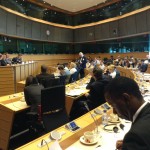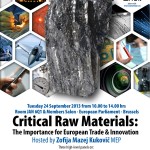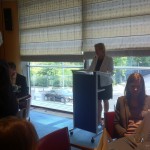Luckily, today, after five years of crisis forecasts we have moderate economic growth and consequently an increase in new jobs in the European union.
There are still 27 million unemployed people, of which 5 million are young people. We have to remove as many obstacles to employment as possible. Improving our internal market allows us to compete less amongst each other and more with the rest of the world. We have to be aware of how to address the risks that are very much present in raw materials. This is especially difficult for smaller member states, as they have even more obstacles in accessing them.
We need to find a balance between on the one hand health and the environment, and technology and industry on the other. Every technology has an impact on the environment and health, just as every medicine has side effects. How can we find a balanced and acceptable limit? We can through innovation, research and materials. The European Parliament has in its resolution in 2011 stated its support for rare and critical raw materials for Europe, on which the industry and the citizens of Europe depend.
Managing illnesses is especially important for the European Union. One third of people are already over 65 years who, with children, are most vulnerable. Development is focusing on healthy lifestyles, quality diagnostics, high-quality equipment for operations and also emergency medicine. This is especially important because one in every four people, no matter the age, will develop cancer.
To develop solutions for all of what has been mentioned, we need the best available technology that is made from the best materials. Most of this development is based on rare materials, which includes beryllium.
Miniature optical lasers are just one of the advances being used in the newest, non-invasive surgical techniques. Such techniques reducer patient trauma and infection risk, while speeding the process of healing and recovery.
Telemedicine cannot be developed or implemented without mobile devices. Even these devices require critical raw materials for their development. The commission has identified 14 raw materials as critical. Regrettably, what is defined as critical in the EU, also has a greater price on a global market.
There is great opportunity in a more systematic use of waste and greater efficient use of materials. Europe’s opportunity is also in efficient recycling and re-use and also finding substitutes. This will allow for a diversified supply. Horizon 2020 is an EU programme that will support the development of solutions. Although, the underlying risk, how to get to the raw materials is still there. We also need to make sure that we develop standard safety measures for workers working with these materials, because a part of them is toxic.
I have personally met with obstacles in the FTA between the European Union and India, which has been in development already for many years and it has yet to see the finish.
The Free trade agreement between the EU and USA has been pending for a long time.
Critical raw materials are critical for Europe and for our future. They are necessary to maintain the lead that we have in science and in innovation, and they can also help us regain the lead where we do not. We cannot talk about growth and jobs on the one hand, and yet not support the drivers of that growth on the other. As policymakers we need to understand the needs of the citizens, the needs of the market, the needs of health and the needs of the environment. We need to find a balance in regulation with transparent methodology to allow for innovation in science and its applications to be supported. If we do not create the right business environment, then Europe will decline in competitiveness. A real vision is needed to achieve Europe’s reindustrialisation while maintaining the highest level of care for health of the people and the environment.
– Zofija Mazej Kukovič




